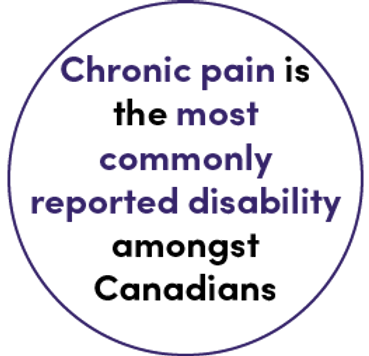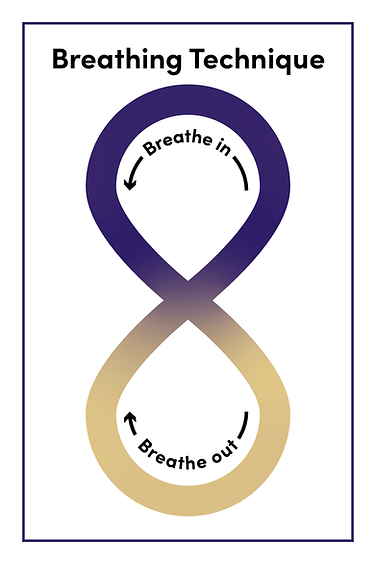According to the most recent Participation and Activity Limitations survey, chronic pain is the most commonly reported disability amongst Canadians.
While pain is often associated with a specific incident or condition, chronic pain extends beyond this original trigger to impact all aspects of everyday life for an extended period of time. Managing your pain often becomes a daily task within itself, making it difficult to participate in other tasks which are meaningful to you. Furthermore, pain can limit your ability to physically, socially or psychologically engage in daily life.

Occupational therapy is uniquely suited to help you discover that chronic pain and quality of life can exist simultaneously. With thorough assessment, and task-based, non-pharmaceutical interventions, occupational therapy can help you to take back your daily life from chronic pain!
Pain Assessment

Because we cannot see or feel someone else’s pain, it’s important that your occupational therapist (OT) first understands your unique pain experience. With assessment of pain quality, severity, triggers and mediators, we will gain a better understanding of how pain impacts your daily life, as well as how pain changes over time.
Limiting the Role of Pain in Everyday Life
Pain management might be a main task in your daily life, leaving less time and energy for the rest of your daily occupations. The Gate Theory of Pain suggests that when a non-painful stimulus is introduced, the “gates” that receive painful stimuli are closed. From an occupational therapy lens, this means that, when enjoyable, pain-mediating activities become part of your daily life, your focus on pain will be reduced. Seems simple, right? Occupational therapy can support you in discovering activities that lessen your focus on pain and incorporating those activities into your daily routine.
Coping Strategies
Rather than aiming to eliminate your pain, occupational therapy can support you in finding ways to cope with ongoing pain. This can include an introduction to coping techniques that lessen the physical and psychological impact of pain, such as, mindfulness, meditation and breathing techniques. Further, your occupational therapist (OT) will work with you to find coping strategies specific to your interests, schedule and experience of pain.
Prioritizing, Planning, Pacing & Positioning
The 4 Ps of pain management – prioritizing, planning, pacing, and positioning – can help you to make the most of your day while living with pain. In collaboration with your occupational therapist, you can:
- Determine which tasks are most important to you (prioritizing)
- Identify when you can complete these tasks with limited fatigue or pain (planning)
- Determine how to respect your pain limits (pacing)
- Identify how you can move your body to minimize pain (positioning)
Tying it all Together: A Case Study
Let’s imagine a client – Sarah – has come into the clinic seeking support in managing her fibromyalgia. Sarah has experienced generalized pain related to fibromyalgia over the past three years and often feels like her pain holds her back from accomplishing her daily tasks.
At her first session, Sarah and her OT complete a pain assessment. Unlike the many formal assessments Sarah completed before being diagnosed with fibromyalgia, this assessment feels more like an informal conversation and allows Sarah to explain, in her own words, how her pain impacts her daily life. From this assessment, Sarah’s OT learns that she mostly experiences pain in her hips and knees and describes this pain as a constant, dull ache. Understandably, this pain limits Sarah’s mobility and ability to complete standing tasks. On average, Sarah rates her pain as an 8/10 on a pain scale. Her constant pain causes Sarah to feel extremely fatigued, particularly in the afternoon. However, when she is seated or lying down, Sarah rates her pain as a 3/10. This constant experience of pain is beginning to impact Sarah’s mood and overall quality of life.
First, Sarah and her OT will discuss Sarah’s daily routine, and put the principles of prioritizing, planning, pacing and positioning into motion.
- Prioritizing: Sarah prioritizes that one of the tasks she feels she must complete every day is cooking dinner for herself and her family.
- Planning: Because Sarah knows her fatigue is greatest in the afternoon, she plans to complete most of her cooking in the evening.
- Pacing: Sarah knows that standing for hours at a time while cooking significantly increases her fatigue, to the point where she feels drained for the rest of the evening, and into the next day. Therefore, Sarah paces her cooking tasks by prepping her ingredients in the morning, when her energy is at a maximum, then completes the task in the evening.
- Positioning: Sarah also knows that her fatigue and pain are mediated when seated. So, Sarah positions herself on a high barstool while using the stove and completes meal prep while seated at the kitchen table.

Sarah also incorporates other seated activities into her day as a way to limit the role of pain in her everyday life. During the afternoon, when Sarah’s fatigue is at its peak, Sarah plays piano while seated as a way to lessen her focus on pain, while also allowing her body to recuperate. Sarah also finds playing music to be meditative and helps her to cope with her constant experience of pain. When Sarah is engaged in a standing task and not able to return to the piano, she uses diaphragmatic breathing and quick, mindfulness exercises as a means to cope with the pain and focus on the task at-hand. Although Sarah’s pain will likely always be a part of her life, she comes to find that, with changes to her daily routine, pain does not have to be the only part of her life.
CONTRIBUTED BY: Lauren Macartney, Occupational Therapist, MScOT


.png)


